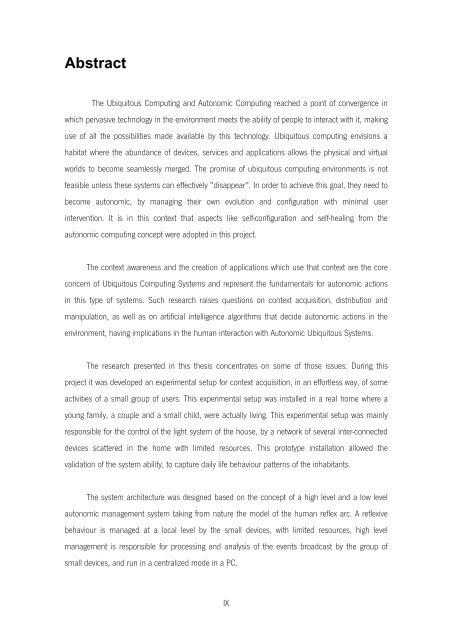Carlos Manuel Rodrigues Machado Autonomic Ubiquitous Computing
Carlos Manuel Rodrigues Machado Autonomic Ubiquitous Computing
Carlos Manuel Rodrigues Machado Autonomic Ubiquitous Computing
Erfolgreiche ePaper selbst erstellen
Machen Sie aus Ihren PDF Publikationen ein blätterbares Flipbook mit unserer einzigartigen Google optimierten e-Paper Software.
Abstract<br />
The <strong>Ubiquitous</strong> <strong>Computing</strong> and <strong>Autonomic</strong> <strong>Computing</strong> reached a point of convergence in<br />
which pervasive technology in the environment meets the ability of people to interact with it, making<br />
use of all the possibilities made available by this technology. <strong>Ubiquitous</strong> computing envisions a<br />
habitat where the abundance of devices, services and applications allows the physical and virtual<br />
worlds to become seamlessly merged. The promise of ubiquitous computing environments is not<br />
feasible unless these systems can effectively "disappear". In order to achieve this goal, they need to<br />
become autonomic, by managing their own evolution and configuration with minimal user<br />
intervention. It is in this context that aspects like self-configuration and self-healing from the<br />
autonomic computing concept were adopted in this project.<br />
The context awareness and the creation of applications which use that context are the core<br />
concern of <strong>Ubiquitous</strong> <strong>Computing</strong> Systems and represent the fundamentals for autonomic actions<br />
in this type of systems. Such research raises questions on context acquisition, distribution and<br />
manipulation, as well as on artificial intelligence algorithms that decide autonomic actions in the<br />
environment, having implications in the human interaction with <strong>Autonomic</strong> <strong>Ubiquitous</strong> Systems.<br />
The research presented in this thesis concentrates on some of those issues. During this<br />
project it was developed an experimental setup for context acquisition, in an effortless way, of some<br />
activities of a small group of users. This experimental setup was installed in a real home where a<br />
young family, a couple and a small child, were actually living. This experimental setup was mainly<br />
responsible for the control of the light system of the house, by a network of several inter-connected<br />
devices scattered in the home with limited resources. This prototype installation allowed the<br />
validation of the system ability, to capture daily life behaviour patterns of the inhabitants.<br />
The system architecture was designed based on the concept of a high level and a low level<br />
autonomic management system taking from nature the model of the human reflex arc. A reflexive<br />
behaviour is managed at a local level by the small devices, with limited resources, high level<br />
management is responsible for processing and analysis of the events broadcast by the group of<br />
small devices, and run in a centralized mode in a PC.<br />
IX

















